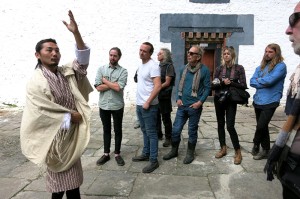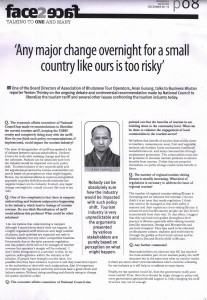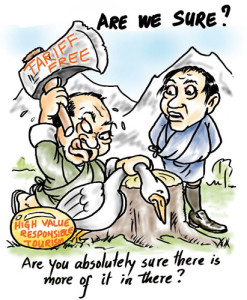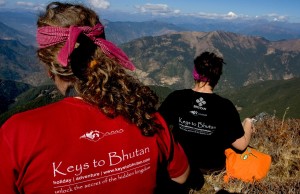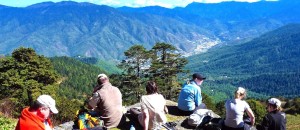
The cost of maximizing tourism benefits
The National Council’s proposed changes in the tourism industry have left the industry divided.
Tour operators are against any reform in the existing tariff or policy while the guides and hoteliers welcome it.
The EAC recommended the government to retain the royalty of USD 65 a day a tourist and lift the tariff to ensure all stakeholders maximize tourism opportunities and minimize revenue leakages.
The EAC’s chairperson and Chukha’s councilor, Pema Tenzin said that the government reviews the Council’s recommendations for its practicality and provides a follow up report on its status.
The players
The tourism industry is governed by the “high value, low impact” policy. All tariff-paying tourists have to route through tour operators. They design the itinerary for tourists, chose hotels and assign a guide and transportation. Tourists who opt to stay in their preferred choice of hotels have to bear the surcharge. Of about 1,700 tour operators, only about 400 are operational. The top 10 tour operators bring in about 30 percent of the total international tourists.
There are about 133 hotels across the country with the highest located in Thimphu, Paro and Punakha. The occupancy rate is about 30 to 35 percent on an average for hotels in the western region, about 17 percent in central and seven percent in the eastern region.
There are about 2,500 licensed guides of which a majority are cultural guides. They are paid about Nu 500 to Nu 1,500 a day during peak season while in the lean season they get about Nu 500 to 1,000.
Today, small vehicles hired for tourists are paid Nu 18 to 21 a km while coaster busses categorized as medium vehicles get about Nu 30 to 35.
Issues
The prominent issues confronting the industry today are hotel occupancy, equal spread of tourism benefits, seasonality and the alleged undercutting practices. The sector has been grappling with these issues for more than four decades.
Questions are also raised on how effective the Tourism Council of Bhutan’s (TCB) and tour operators marketing strategies are. Lack of innovation among tour operators is another issue. A majority of tour operators still sell the same tour packages and every year cultural tourists top the list of arrivals while less than 10 percent visit for adventure tour. Other products such as Buddhism, wellness and spa or biking, community based tourism and retreat are yet to pick up.
Unregulated regional tourist arrivals, which is increasing is seen as a threat to the country’s brand as a niche destination. Until a couple of years ago, regional tourists were not part of the tourism statistics but now the numbers are used as a yardstick for achieving targets.
Hoteliers’ and guides’ stand
Hoteliers and most guides laud the Council’s recommendation on doing away with the fixed tariff. The proposed change, they said would tackle the regional spread of tourism benefits and the seasonality issue. They said in the current system, tour operators decide where guests stay, what they do, eat or visit. The profit from tourism is not distributed within the industry, as tour operators want the lowest price for transportation, hotel, and guides.
Reasoning that hoteliers make the most investment in the industry and create the highest employment, they said its time tour operators promote Bhutan as a niche market instead of undercutting. They said the current system worked only in the past when there were fewer hotels, guides and tour operators.
Three-star hoteliers said they sell a room for about Nu 1,500 to 2,000 a night after offering 30 to 40 percent discount and removing all facilities in a bid to save costs.
“Although there is a huge scope, most hotels are unable to break even,” a hotelier and tour operator in Paro said.
In the current system, hoteliers and guides said that if they don’t have good relations with tour operators, they don’t get business. “Even if a tourist chooses your hotel, the tour operator would tell them that the rooms are booked and move them to another.”
Hoteliers said that the existing system has forced guides to depend on commission and take guests to the shops and hotels, depending on who provides them the highest commission besides demanding free food and lodge from hotels where tour operators keep their guests.
Guides Association of Bhutan’s (GAB) chairman Garab Dorji said the whole issue boils down to undercutting, which he said is rampant. “After offering a huge discount to overseas agents, the discount is pushed onto hotels and guides,” he said. “Hotels and guides don’t have a choice but to accept it as its better to have some guests than none.”
“The proposed changes will level the field for all where everyone gets equal chance,” Garab Dorji said.
It is alleged that most tour operators especially the bigger players sell tour packages for USD 130 to 170 a day.
Hotels and Restaurants Association of Bhutan’s (HRAB) president Thinley Palden Dorji said there is no denying that there is a problem.
“There is an issue with the way the industry is structured,” he said, calling for reform for the long-term health of the industry. “What makes the situation worse is that many hotels don’t receive their payment on time.”
Tour Operators’ take
Tour operators contend that not all undercut. They insist that any reform in the policy would affect the industry and Bhutan as a destination. Their argument is mainly based on “why fix something that is not broken” and that any change would mean, “killing the golden goose.”
Tour operators argue that if changes come through, it would mean undercutting is legalized. The increase in tourists, they said would promote mass tourism considering the tourist population ratio.
“The carrying capacity in terms of services and infrastructure need to be studied well,” a tour operator said, adding that any reform would add pressure on the limited resources.
Some tour operators attributed undercutting to management lapses, which they said would worsen if the existing tariff were removed.
“It’s not true that tour operators dictate the market. Not anymore,” one said. “It used to function that way in the 90s where information was solely dependent on tour operators but today hoteliers market themselves while clients seek information online prior to their visits.”
They said that although the price or tariff is just one component of the overall aspect of tourism, it was different for Bhutan as the tariff is the only factor that has maintained the country’s policy of high value, low impact for the past 41 years.
“Instead of meddling with the tariff that has worked so well, its time we come up with a proper plan and system in place,” Association of Bhutanese Tour Operators’ (ABTO) executive director Sonam Dorje said.
Citing that there are bigger issues that need to be tackled, Sonam Dorje said that tour operators are not adverse to change but first quality, standardization and professionalism in the industry should be addressed.
“Lets put our house in order first and have the system in place and then talk about the price,” Sonam Dorje said.
Some tour operators also said there are no basic infrastructure in place currently to maximize from the increase in arrivals if the tariff was removed. They also questioned how the reform would guarantee regional spread of tourism benefits and address the seasonality and occupancy issue for hotels.
The change in tariff, a tour operator said would be the beginning of an end. “It’s not right to malign tour operators when there is nothing wrong with the policy,” he said. “Brand Bhutan wasn’t created overnight, it was a deliberate approach to economic development. The brand is immeasurable.”
Referring to the occupancy issue and bad debts of hotels, another tour operator said that it was not the government’s job to bail out failed businesses. “The realty is that if the tariff system is removed, another 100 hotels will come up again and the same issues will exist.”
Council’s stand
EAC chairperson Pema Tenzin said the Council was looking at maximizing the policy by removing the fixed tariff.
On the accusation from tour operators that they were not consulted, Pema Tenzin said the committee has done enough consultation even before the 15th session.
He said all members sought views on the issue during their constituency visits besides consulting TCB, ABTO, HRAB and GAB, among others. “There were guides, foreigners, and people from non-tourism sectors who wrote to us,” he said.
The Council’s stand, he said is to stop mass tourism and encourage high-end tourists and address the existing issues in the industry.
“The royalty will serve as the pricing mechanism to avoid budget tourists,” he said, while emphasizing the need to manage regional tourists stating that Bhutan cannot have two standards for tourists. “Let the market decide,” he said.
Pema Tenzin also said that TCB, as the apex body, instead of stamping visas and calculating the daily tariff, have a bigger mandate.
On the possibility of tax evasion and revenue leakages given the poor monitoring system in place currently, Pema Tenzin said the government must ensure an aggressive taxation system.
Meanwhile, Drukair’s CEO Tandi Wangchuk said that although it’s difficult to take a stand at the moment, an increase in passengers would mean additional business for the airlines.
“As a carrier, we will be happy with any policy that ensures increase in tourist arrivals and throughout the year,” he said.
TCB officials did not want to comment.
Source: Kuensel (Kinga Dema)

